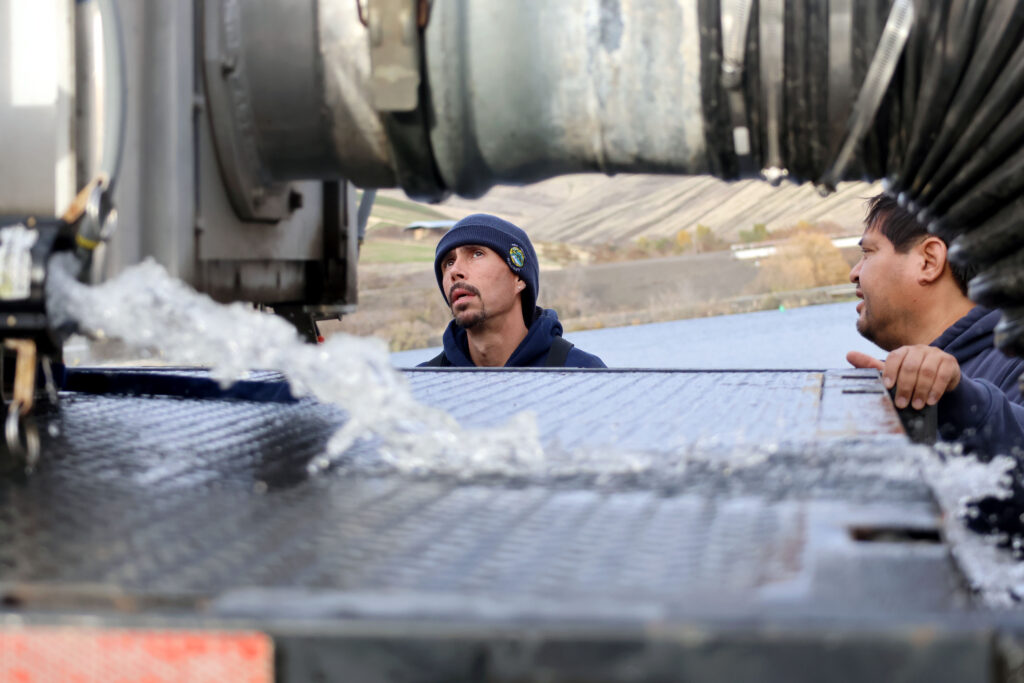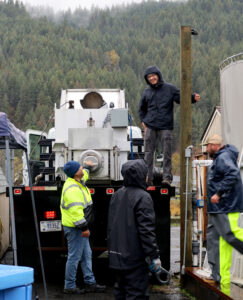![]()
Most people know that anadromous fish like salmon die shortly after they spawn. Most steelhead in the Columbia Basin only spawn once, as well. But when the conditions are right, steelhead can spawn a second time. Around two percent of the Columbia Basin steelhead population successfully spawns twice. These repeat spawners are called “kelts.” Thousands try to migrate to the ocean after spawning but die before getting there due to limitations on downstream adult fish passage at hydroelectric dams. As a result, fewer are found in the upper Columbia and Snake than elsewhere in the basin.
In a joint effort to support the survival of wild steelhead, the Yakama Nation, the Nez Perce Tribe, the Columbia River Inter-Tribal Fish Commission (CRITFC), and the University of Idaho have come together to support populations of this culturally significant fish.

Dworshak National Fish Hatchery Aquaculture Technician, Kemo Scott (Nez Perce), submerges the release hose before 800 gallons of water wash a truckload of steelhead kelts fish into the Snake River. To ensure safe release, the hose is held underwater while water from the transport tank is expelled.
The project, known as the Kelt Reconditioning Project, aims to assist steelhead in becoming repeat spawners, a unique trait that has become increasingly rare due to mounting challenges. These mature fish face threats such as sea lions, invasive predators, dams, and fishers. Recent years have seen the added danger of rising temperatures, making this project crucial for the survival of these remarkable fish. As this year is projected to be the warmest in 174 years, the tribes hold major concerns for the well-being of their native aquatic foods, with steelhead being of paramount importance.

A Dworshak National Fish Hatchery technician uses a dipnet to fish steelhead out of their holding tank in preparation for transport to their destination near the Lower Granite Dam. Photo: Jill-Marie Gavin, CRITFC
Tribes, being leaders and innovators in natural resource management, developed this project to provide support to these steelhead to increase their survival rates.
Releases on November 7 in both the Yakama and Nez Perce homelands were the culmination of a reconditioning process that began this spring. Outmigrating kelts were collected after spawning and held and fed at the Prosser Hatchery and Dworshak National Fish Hatchery to increase their chances to survive and to rebuild energy reserves required for repeat spawning. By collecting and reconditioning kelts, the tribal programs are acquiring wild steelhead spawners from a group of fish that most likely would have died.
This second spawning generally yields twice as many eggs as the first, making it a vital endeavor for the preservation of the species. The National Marine Fisheries Service recognized the Kelt Reconditioning Project as the sole hatchery action in the basin directly enhancing wild steelhead abundance.
The timing of the release coincides with the river’s main steelhead run to ensure the reconditioned kelts have plenty of spawning potential. By increasing their survival, more kelts have the potential to be a valuable contributor to ESA-listed steelhead populations, a crucial aspect of sustaining the local ecosystem and supporting fish populations in the Snake River.

DNFH Fisheries Aquaculture Technicians Kemo Scott, left, and Eric Ellenwood drain water out of the 800-gallon tank holding steelhead being released into the Snake River near Lower Granite Dam. To avoid an overwhelming rush of water, the tank is partially drained before opening the hatch to release the fish. Photo: Jill-Marie Gavin, CRITFC
The Columbia River treaty fishing tribes remain the only fisheries managers conducting steelhead kelt reconditioning research in the Columbia Basin. These programs have been successful in discovering which reconditioning strategies and methods work best. This program has proven success in improving wild steelhead survival by having them avoid passing as many as nine mainstem dams two more times, going out to the ocean and returning to spawning grounds, as well as predation and unpredictable ocean conditions.
In the Yakama Nation homelands, just over 100 adult wild steelhead kelts were released from the Prosser Hatchery into the Yakima River, a momentous event considering the declining population collected at the hatchery in recent years. Ryan Branstetter, CRITFC Fishery Biologist, emphasized the unsettling nature of this trend, highlighting the immense pressure the fish are under.
“Fluctuations in the population numbers are to be expected. But knowing the type of pressure these fish are facing makes it very unsettling when you see their numbers dip this low,” said Branstetter.

Employees of the Dworshak National Fish Hatchery and CRITFC take a break from their Kelt Project duties. Photo: Jill-Marie Gavin, CRITFC
Two hundred miles away along the Clearwater River in Idaho CRITFC and the Nez Perce Tribe were conducting the same work at the Dworshak National Fish Hatchery (DNFH) and Nez Perce Tribal Fish Hatchery. This Kelt Project focuses on releasing fish to sustain the local ecosystem and bolster fish populations in the Snake River. With careful handling, each fish is also equipped with a Passive Integrated Transponder (PIT) tag, ensuring their proper identification.
The crew in Idaho processed approximately 45 fish per tank, with two tanks being packed with meticulous care taken to ensure their safety. Once prepared, the fish embarked on a two and a half-hour journey downriver below Lower Granite Dam. where they were released into the Snake River.
Both the Yakama Nation Prosser Hatchery and Dworshak National Fish Hatchery welcome youth tours, encouraging the next generation to learn more about salmon and steelhead and explore careers in fishery sciences. that will aid in the protection of natural resources.
As tribes prepare for climate impacts on their First Foods and sacred relatives of their rivers, efforts like the Kelt Reconditioning project will become more and more important to protect Columbia Basin natural resources. They also encourage all residents of the Pacific Northwest to appreciate the steelhead as they continue to make their ancient journey, recognizing their role in our ecosystem and the hope that they hold for future generations.



